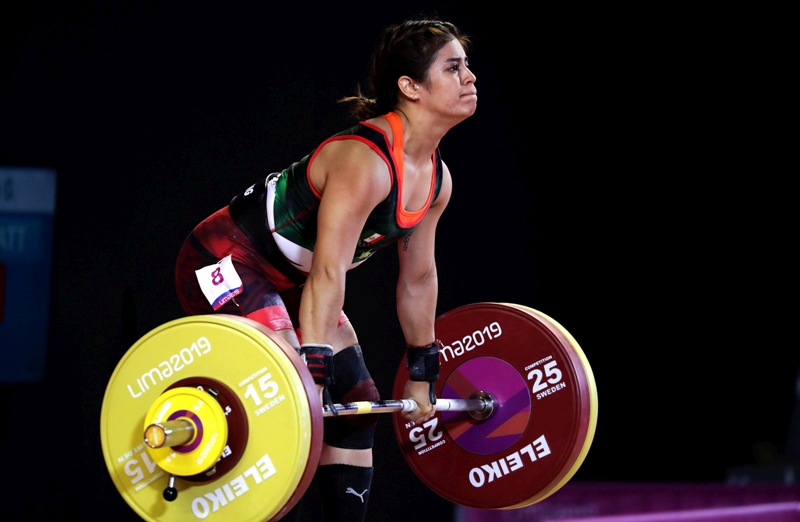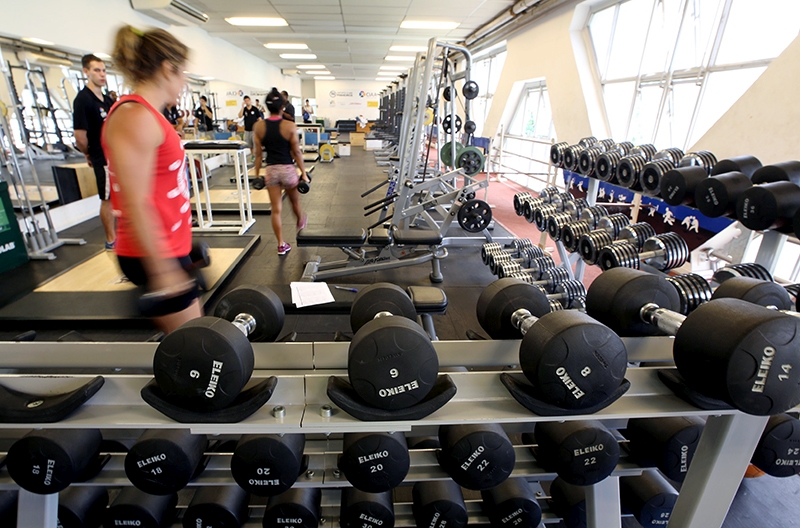You are viewing 1 of your 1 free articles. For unlimited access take a risk-free trial
Strength training for sport: how much is too much?

What’s the optimum volume of strength training to ensure maximum sport-performance gains? Sports Performance Bulletin looks at some recent research suggesting that less could be more…
Regular Sports Performance Bulletin subscribers will be well aware of the benefits that a properly constructed and implemented strength-training programme can produce on athletic performance. An obvious benefit is that the increased resilience of stronger muscles can help reduce the risk of injury – both those arising from inherent weaknesses and those of strength imbalances.Another clear benefit is for athletes whose sports require strength and power, or those engaging in sports, which although primarily endurance in nature, require occasional bursts of power – for example, a sprint for the finish line or a mid-race burst to break away from the pack. And if you’re still not convinced of the benefits of strength training, consider also that a large body of research has established that strength training can significantly boost endurance muscle efficiency - more technically known as ‘economy’(1-5). See this article for a more in-depth article on muscle economy and how to improve it (also see figure 1). In plain English, this means that endurance athletes who strength train are able to run/cycle/swim at a sub-maximal pace for a reduced oxygen (and therefore energy) consumption, resulting in extended endurance capacity.
Figure 1: Summary of some recent findings on strength training and muscle economy(1-5)

Adding strength training to an existing programme
The evidence for the benefits of strength training for virtually all athletes is undeniable. But how should athletes go about adding strength exercise to an existing programme? It goes without saying that any resistance/strength programme needs to target the key muscle groups used in your sport with the right exercises.Another requirement is that the loading and reps of these chosen exercises are tailored to the requirements of the individual athlete. There are varying ideas about this, but the consensus among most exercise physiologists, coaches and strength trainers is that the load should be sufficient to induce high levels of fatigue - somewhere between 4 and 10 reps(6). Novice trainers may benefit from lower loadings and higher reps in this range, while experienced trainers (especially those whose sports are primarily strength-power focussed) are likely to benefit from higher loadings and lower reps in the range). For a more detailed discussion on this topic, see this Sports Performance Bulletin article.
A more controversial question (and one that often causes more headaches for athlete) is how much strength training is needed/optimal and how should this extra training load be integrated into an existing programme? In particular, while some strength is undoubtedly beneficial, adding too much to a training programme is likely to be counterproductive and even risky. These risks are as follows:
- Overtraining: when total training load rises too rapidly, overtraining resulting in fatigue, illness and even burnout can occur. Since strength training by its very nature is high-intensity, even small amounts of strength training added to an existing training programme can significantly increase total training loading (for a more detailed understanding of how to calculate training loads, see this excellent article).
- Displacement: to avoid overtraining, an option is to reduce the volume of your core sport training to make way for strength work. However, reduce this too much to make way for strength training, and you may end up losing more than you gain from adding in strength training!
- High-intensity interference: the intense nature of strength training means that scheduling your other high-intensity training (eg intervals) becomes logistically more difficult, especially if you are strength training three or more times per week.
- Time constraints: not a risk as such, but most athletes also have other commitments such as family and work, which make long and frequent gym sessions difficult and undesirable!
Good news: why less might be more
The obvious questions at this point are 1) What is the minimum volume of strength training that is effective for producing significant gains and 2) Does increasing strength training volume automatically result in greater gains? These are questions that have hitherto been poorly researched, but a brand new study on the relationship between strength training volume and benefits derived makes for fascinating reading(7).In this study, researchers set out to compare the effects of different resistance training volumes on muscle performance and hypertrophy (gains in muscle mass) in trained men. Thirty seven subjects performed the same resistance training exercises for 24 weeks but were split into groups depending on the numbers of sets performed per muscle group each week. These four groups were:
- *Five sets per week
- *Ten sets per week
- *Fifteen sets per week
- *Twenty sets per week
The results showed that while all groups increased their performances in the 10-rep max tests, the 5 and 10-set per week groups experienced significantly GREATER performance gains than the 15 and 20-set groups. There was also a trend for muscle mass gains in the 5 and 10-set groups – a trend not observed in the 15 and 20-set groups), although this trend was too small to be considered statistically significant. The researchers concluded that ‘our results provide evidence of an inverted ‘U-shaped curve’ (see figure 2) for the dose-response curve for muscle strength and training volume, and that ‘5 to 10 sets per week might be sufficient for bringing about optimal gains in muscle size and strength in trained men over a 24-week period’.
Figure 2: Relationship between weekly volume of sets per muscle group and benefits derived(7)
 The sweet spot in terms of maximum strength gains (blue line) was in the region of 5-10 sets of exercise per muscle group per week (green range). Adding more volume (red range) resulted in reduced gains!
The sweet spot in terms of maximum strength gains (blue line) was in the region of 5-10 sets of exercise per muscle group per week (green range). Adding more volume (red range) resulted in reduced gains!Supporting evidence
These findings are supported by an earlier study by the same group of researchers, which was published earlier this year(8). Using the same 5/10/15/20 set protocol, the researchers examined the effects of different strength-training volumes in women. Like the study above, the greatest strength gains were observed with the lower-volume 5 and 10-set per week protocols. Higher volumes resulted in less strength gains. Interestingly, the women training with 5 and 10 sets per week also gained more muscle mass than the 15 and 20-set groups – and in this study, the extra gains were very significant. Once again, the researchers concluded that ‘5 to 10 sets per week might be sufficient for attaining gains in muscle size and strength in trained women and there appears no further benefit by performing higher exercise volumes’.Further evidence for the ‘less is more’ effect in strength training is provided by a 2015 review study (a study that pools together the findings from previous studies on a particular topic)(9). In this study, researchers carried out a systematic analysis of randomised controlled trials that could improve muscle strength and mass in untrained but healthy older adults. It concluded that volume-wise, a training frequency of three sessions per week employing two to three sets per exercise turned out to be most effective. And that’s interesting because it suggests that around 6-9 sets per week per muscle group is particularly effective – slap bang in the middle of the 5-10 sets per week of the studies discussed above!
Summary and recommendations
Although something of a grey area, recent research is homing in on the volume of strength training that might be most effective for athletes. Studies on men and women, old and young, trained and untrained all suggest that the sweet spot is around 5-10 sets per muscle per week. Less than that is insufficient to produce optimum results. More than 10 sets is likely to excessively overload muscle tissue, impairing recovery, in turn reducing strength and muscle mass gains.For athletes, this is good news; a relatively low volume of training is much more easily accommodated into an existing programme. For example, six sets per muscle group per week could mean just two workouts per week employing three sets per muscle group per workout. With maybe three or four sport-specific muscle groups to target, this would entail just 9-12 sets per workout, enabling the athlete to complete a strength session in 20-30 minutes maximum –relatively easy to slot into a busy training schedule!
Of course, the quality of the exercise movement and loading-reps combination is important as ever; this is where the expertise of a coach or strength and conditioning trainer becomes invaluable. However, if these options aren’t available, readers are directed to the links above and below on how to put together a sport-appropriate strength programme.
References
- Scand J Med Sci Sports. 2002 Oct;12(5):288-95
- J Strength Cond Res. 2005 Nov;19(4):826-30
- J Strength Cond Res. 2010 Aug;24(8):2157-65
- Med Sci Sports Exerc. 2008 Jun;40(6):1087-92
- J Strength Cond Res. 2006 Nov;20(4):947-54
- PLoS One. 2017 Oct 20;12(10):e0186601
- Int J Sports Physiol Perform. 2019 Jun 12:1-23
- Med Sci Sports Exerc. 2019 Mar;51(3):515-52
- Sports Med. 2015 Dec;45(12):1693-720
Newsletter Sign Up
Testimonials
Dr. Alexandra Fandetti-Robin, Back & Body Chiropractic
Elspeth Cowell MSCh DpodM SRCh HCPC reg
William Hunter, Nuffield Health
Newsletter Sign Up
Coaches Testimonials
Dr. Alexandra Fandetti-Robin, Back & Body Chiropractic
Elspeth Cowell MSCh DpodM SRCh HCPC reg
William Hunter, Nuffield Health
Keep up with latest sports science research and apply it to maximize performance
Today you have the chance to join a group of athletes, and sports coaches/trainers who all have something special in common...
They use the latest research to improve performance for themselves and their clients - both athletes and sports teams - with help from global specialists in the fields of sports science, sports medicine and sports psychology.
They do this by reading Sports Performance Bulletin, an easy-to-digest but serious-minded journal dedicated to high performance sports. SPB offers a wealth of information and insight into the latest research, in an easily-accessible and understood format, along with a wealth of practical recommendations.
*includes 3 coaching manuals
Get Inspired
All the latest techniques and approaches
Sports Performance Bulletin helps dedicated endurance athletes improve their performance. Sense-checking the latest sports science research, and sourcing evidence and case studies to support findings, Sports Performance Bulletin turns proven insights into easily digestible practical advice. Supporting athletes, coaches and professionals who wish to ensure their guidance and programmes are kept right up to date and based on credible science.












